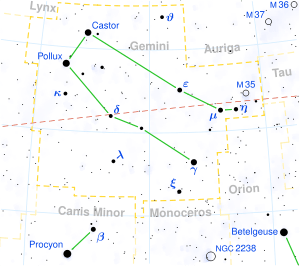TV Geminorum
TV Geminorum (TV Gem / HD 42475 / HR 2190) is a variable red supergiant in the constellation Gemini. Its visual magnitude varies from 6.3 to 7.5.
 | |
| Observation data Epoch J2000 Equinox J2000 | |
|---|---|
| Constellation | Gemini |
| Right ascension | 06h 11m 51.41401s[1] |
| Declination | 21° 52′ 05.6452″[1] |
| Apparent magnitude (V) | 6.27 - 7.50[2] |
| Characteristics | |
| Spectral type | K5.5 - M1.3 Iab[3] + B4 III:[2] |
| U−B color index | +1.77[4] |
| B−V color index | +2.25[4] |
| Variable type | SRc[3] |
| Astrometry | |
| Radial velocity (Rv) | +20.42[5] km/s |
| Proper motion (μ) | RA: −0.575[6] mas/yr Dec.: −2.598[6] mas/yr |
| Parallax (π) | 0.3197 ± 0.1301[6] mas |
| Distance | 1,500[7] pc |
| Absolute magnitude (MV) | -6.31[8] |
| Details | |
| Mass | 14[9] M☉ |
| Radius | 623[10], 620 - 710 (pulsation)[7] R☉ |
| Luminosity | 68,000 ± 34,900[10], 62,000 - 89,000[7] L☉ |
| Temperature | 3,750 ± 120[10], 3,500 - 3,850[7] K |
| Other designations | |
| Database references | |
| SIMBAD | data |
Location
TV Gem is less than a degree SW of η Geminorum. It is a member of the Gemini OB1 stellar association at around 4,500 light years from Earth.[8]
Variability
TV Geminorum is classified as a semi-regular variable star, meaning that its brightness changes are not predictable, but do show some periodicity. The General Catalogue of Variable Stars does not list a period,[3] but the International Variable Star Index gives an uncertain period of 229 days.[2] A detailed study of TV Gem between 1997 and 2014 detects periods of 411 days and 3,137 days.[7]
Properties
TV Geminorum changes its size, temperature, and luminosity as its brightness varies. The temperature changes between 3,500 K and 3,850 K, the radius between 620 R☉ and 710 R☉, and the bolometric luminosity between 62,000 L☉ and 89,000 L☉. The majority of the electromagnetic radiation is emitted at wavelengths longer than the visual band, being only around 20,000 times brighter than the sun at visual wavelengths.
The pulsations are not correlated with the brightness changes in the expected way; other pulsating variables are brightest when they are hottest and smallest, but TV Gem does not follow this rule. It has been suggested that the luminosity variations are affected by the formation of supergranules surrounding the star.[7] The spectral type varies in line with the temperature changes, from as early as K5.5 to as late as M1.3. The type M1.3 is assigned by a numerical calculation from photometry.[11] The MK spectral class is M0 - M1.5 Iab.[12]
If TV Gem was at the centre of the solar system, the four inner planets, including the Earth, would be encompassed within the star. It is losing mass at an annual rate of 3.5×10−7M☉.[13]
Companion
TV Gem appears to have a very close hot companion. Its existence is inferred from an ultraviolet excess in the spectral energy distribution. The spectral type determined from the ultraviolet portion of the spectrum is B4, appearing to be a giant although it is thought that this is caused by the stellar wind from an underlying main sequence star. It is estimated to have an apparent magnitude of 11.2 and an absolute magnitude of −1.4.[14]
See also
References
- Van Leeuwen, F. (2007). "Validation of the new Hipparcos reduction". Astronomy and Astrophysics. 474 (2): 653. arXiv:0708.1752. Bibcode:2007A&A...474..653V. doi:10.1051/0004-6361:20078357.
- Watson, C. L. (2006). "The International Variable Star Index (VSX)". The Society for Astronomical Sciences 25th Annual Symposium on Telescope Science. Held May 23–25. 25: 47. Bibcode:2006SASS...25...47W.
- Samus, N. N.; Durlevich, O. V.; et al. (2009). "VizieR Online Data Catalog: General Catalogue of Variable Stars (Samus+ 2007-2013)". VizieR On-line Data Catalog: B/gcvs. Originally Published in: 2009yCat....102025S. 1. Bibcode:2009yCat....102025S.
- Ducati, J. R. (2002). "VizieR Online Data Catalog: Catalogue of Stellar Photometry in Johnson's 11-color system". CDS/ADC Collection of Electronic Catalogues. 2237. Bibcode:2002yCat.2237....0D.
- Famaey, B.; Jorissen, A.; Luri, X.; Mayor, M.; Udry, S.; Dejonghe, H.; Turon, C. (2005). "Local kinematics of K and M giants from CORAVEL/Hipparcos/Tycho-2 data. Revisiting the concept of superclusters". Astronomy and Astrophysics. 430: 165. arXiv:astro-ph/0409579. Bibcode:2005A&A...430..165F. doi:10.1051/0004-6361:20041272.
- Brown, A. G. A.; et al. (Gaia collaboration) (August 2018). "Gaia Data Release 2: Summary of the contents and survey properties". Astronomy & Astrophysics. 616. A1. arXiv:1804.09365. Bibcode:2018A&A...616A...1G. doi:10.1051/0004-6361/201833051. Gaia DR2 record for this source at VizieR.
- Wasatonic, Richard P.; Guinan, Edward F.; Durbin, Allyn J. (2015). "V-Band, Near-IR, and TiO Photometry of the Semi-Regular Red Supergiant TV Geminorum: Long-Term Quasi-Periodic Changes in Temperature, Radius, and Luminosity". Publications of the Astronomical Society of the Pacific. 127 (956): 1010. Bibcode:2015PASP..127.1010W. doi:10.1086/683261.
- Levesque, Emily M.; Massey, Philip; Olsen, K. A. G.; Plez, Bertrand; Josselin, Eric; Maeder, Andre; Meynet, Georges (2005). "The Effective Temperature Scale of Galactic Red Supergiants: Cool, but Not As Cool As We Thought". The Astrophysical Journal. 628 (2): 973. arXiv:astro-ph/0504337. Bibcode:2005ApJ...628..973L. doi:10.1086/430901.
- Stothers, R.; Leung, K. C. (1971). "Luminosities, masses and periodicities of massive red supergiants". Astronomy and Astrophysics. 10: 290. Bibcode:1971A&A....10..290S.
- Mondal, Soumen; Chandrasekhar, T. (2005). "Angular Diameter Measurements of Evolved Variables by Lunar Occultations at 2.2 and 3.8 Microns". The Astronomical Journal. 130 (2): 842–852. arXiv:astro-ph/0504326. Bibcode:2005AJ....130..842M. doi:10.1086/430457.
- White, N. M.; Wing, R. F. (1978). "Photoelectric two-dimensional spectral classification of M supergiants". Astrophysical Journal. 222: 209. Bibcode:1978ApJ...222..209W. doi:10.1086/156136.
- Keenan, Philip C.; McNeil, Raymond C. (1989). "The Perkins catalog of revised MK types for the cooler stars". Astrophysical Journal Supplement Series. 71: 245. Bibcode:1989ApJS...71..245K. doi:10.1086/191373.
- Mauron, N.; Josselin, E. (2011). "The mass-loss rates of red supergiants and the de Jager prescription". Astronomy and Astrophysics. 526: A156. arXiv:1010.5369. Bibcode:2011A&A...526A.156M. doi:10.1051/0004-6361/201013993.
- Buss, Richard H.; Snow, Theodore P. (1988). "Hot components and circumstellar grains in M supergiant syncretic binaries". Astrophysical Journal. 335: 331. Bibcode:1988ApJ...335..331B. doi:10.1086/166931.